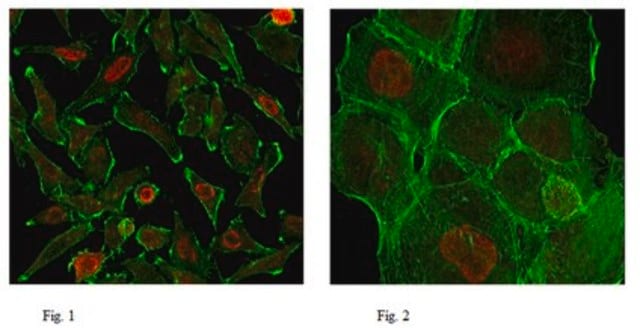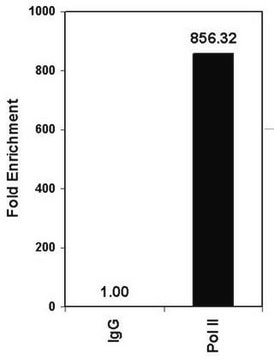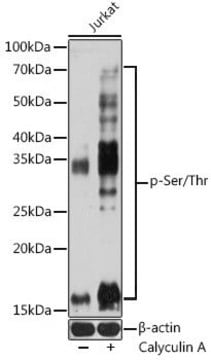SAB4200638
Monoclonal Anti−phospho−RNA polymerase II CTD (pSer5) antibody produced in rat
clone 1H4B6, purified from hybridoma cell culture
Synonyme(s) :
CCFDN, CTD (carboxy−terminal domain, RNA polymerase II, polypeptide A) phosphatase, CTD of POLR2A, FCP1, POLR2, POLRA, RNA polymerase II subunit A C-terminal domain phosphatase, RPB1, RPBh1, RPO2, RPOL2, RpIILS, TFIIF-associating CTD phosphatase 1, hRPB221, hsRPB1, phosphatase of, subunit 1, polymerase (RNA) II (DNA directed) polypeptide A 220kDa (POLR2A), serine phosphatase FCP1a, subunit 1CTDP1, transcription factor IIF-associating CTD phosphatase 1
About This Item
Produits recommandés
Source biologique
rat
Niveau de qualité
Forme d'anticorps
purified from hybridoma cell culture
Type de produit anticorps
primary antibodies
Clone
1H4B6, monoclonal
Poids mol.
~250 kDa
Espèces réactives
human, rat, mouse, monkey, canine
Concentration
~1 mg/mL
Technique(s)
immunoblotting: 0.5-1 μg/mL using whole extracts of HeLa cells.
immunofluorescence: 4-8 μg/mL using using HeLa cells.
Isotype
IgG2b
Numéro d'accès UniProt
Conditions d'expédition
dry ice
Température de stockage
−20°C
Modification post-traductionnelle de la cible
phosphorylation (pSer5)
Informations sur le gène
human ... POLR2A(5430)
mouse ... Polr2a(20020)
rat ... Polr2a(363633)
Description générale
Spécificité
Immunogène
Application
Actions biochimiques/physiologiques
Forme physique
Stockage et stabilité
Clause de non-responsabilité
Not finding the right product?
Try our Outil de sélection de produits.
Code de la classe de stockage
10 - Combustible liquids
Classe de danger pour l'eau (WGK)
WGK 1
Point d'éclair (°F)
Not applicable
Point d'éclair (°C)
Not applicable
Certificats d'analyse (COA)
Recherchez un Certificats d'analyse (COA) en saisissant le numéro de lot du produit. Les numéros de lot figurent sur l'étiquette du produit après les mots "Lot" ou "Batch".
Déjà en possession de ce produit ?
Retrouvez la documentation relative aux produits que vous avez récemment achetés dans la Bibliothèque de documents.
Notre équipe de scientifiques dispose d'une expérience dans tous les secteurs de la recherche, notamment en sciences de la vie, science des matériaux, synthèse chimique, chromatographie, analyse et dans de nombreux autres domaines..
Contacter notre Service technique








